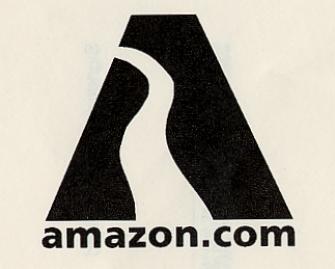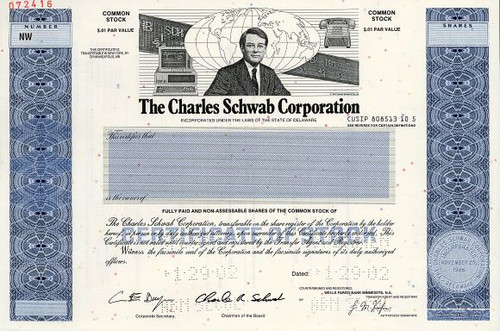Beautiful engraved RARE specimen certificate from the Amazon.Com printed in 1996. This historic document was printed by the United States Banknote Corporation and has an ornate block border with a vignette of the old company logo. The newer certificates have the company's latest logo. This item has the printed signatures of the company's officers, including Jeff Bezos as president and Chief Executive Officer and CFO, Joy Covey. This is only the second Amazon specimen certificate we have had for sale with the old logo.

Certificate Vignette
History Jeff Bezos was researching the Internet in the early 1990s for hedge fund D.E. Shaw. He realized that book sales would be a perfect fit with e-commerce because book distributors already kept meticulous electronic lists. Bezos, who as a teen had dreamed of entrepreneurship in outer space, took the idea to Shaw. The company passed on the idea, but Bezos ran with it, trekking cross country to Seattle (close to a facility owned by major book distributor Ingram) and typing up a business plan along the way. Bezos founded Amazon.com in 1994. After months of preparation, he launched a Web site in July 1995 (Douglas Hofstadter's Fluid Concepts and Creative Analogies was its first sale); it had sales of $20,000 a week by September. Bezos and his team kept working with the site, pioneering features that now seem mundane, such as one-click shopping, customer reviews, and e-mail order verification. Amazon.com went public in 1997. Moves to cement the Amazon.com brand included becoming the sole book retailer on America Online's public Web site and Netscape's commercial channel. In 1998 the company launched its online music and video stores, and it began to sell toys and electronics. Amazon.com also expanded its European reach with the purchases of online booksellers in the UK and Germany, and it acquired the Internet Movie Database. Bezos also expanded the company's base of online services, buying Junglee (comparison shopping) and PlanetAll (address book, calendar, reminders). By midyear Amazon.com had attracted so much attention that its market capitalization equaled the combined values of profitable bricks-and-mortar rivals Barnes & Noble and Borders Group, even though their combined sales were far greater than the upstart's. Late that year Amazon.com formed a promotional link with Hoover's, publisher of this profile. After raising $1.25 billion in a bond offering early in 1999, Amazon.com began a spending spree with deals to buy all or part of several dot-coms. However, some have since been sold (HomeGrocer.com) and others have gone out of business or bankrupt -- Pets.com, living.com (furniture). It also bought the catalog businesses of Back to Basics and Tool Crib of the North. Amazon.com began conducting online auctions in early 1999 and partnered with venerable auction house Sotheby's. Also that year Amazon.com added distribution facilities, including one each in England and Germany. In 2000 Amazon.com placed a link to drugstore.com on its homepage; drugstore.com will pay more than $100 million for that access. In 2000 Amazon.com inked a 10-year deal with toysrus.com to set up a co-branded toy and video game store. Also that year Amazon.com added foreign-language sites for France and Japan. In January 2001 Amazon.com announced plans to restructure and lay off 15% of its workforce; the plan, resulting from the need to show a profit, forced a $150 million charge. In April 2001 the company announced a deal with Borders to provide inventory, fulfillment, content, and customer service for borders.com. In July 2001 America Online invested $100 million in Amazon.com as part of a deal to expand their marketing partnership
The following was from the company's prospectus in 1996:
THE COMPANY
Amazon.com is the leading online retailer of books. Since opening for
business as "Earth's Biggest Bookstore" in July 1995, the Amazon.com bookstore
has quickly become one of the most widely known, used and cited commerce sites
on the World Wide Web (the "Web"). Amazon.com strives to offer its customers
compelling value through innovative use of technology, broad selection,
high-quality content, a high level of customer service, competitive pricing and
personalized services. As an online bookseller, Amazon.com has virtually
unlimited online shelf space and can offer customers a vast selection through an
efficient search and retrieval interface. The Company offers more than 2.5
million titles, including most of the estimated 1.5 million English-language
books believed to be in print, more than one million out-of-print titles
believed likely to be in circulation and a smaller number of CDs, videotapes and
audiotapes. Beyond the benefits of selection, purchasing books from Amazon.com
is more convenient than shopping in a physical bookstore because online shopping
can be done 24 hours a day and does not require a trip to a store. Furthermore,
Amazon.com's high inventory turnover, lack of investment in expensive retail
real estate and reduced personnel requirements give it meaningful structural
economic advantages relative to traditional booksellers.
Through March 31, 1997, Amazon.com had sales of more than $32 million to
approximately 340,000 customer accounts in over 100 countries. Average daily
visits (not "hits") have grown from approximately 2,200 in December 1995 to
approximately 80,000 in March 1997, and repeat customers currently account for
over 40% of orders. Time magazine rated Amazon.com one of the 10 "Best Websites
of 1996."
About Specimens Specimen Certificates are actual certificates that have never been issued. They were usually kept by the printers in their permanent archives as their only example of a particular certificate. Sometimes you will see a hand stamp on the certificate that says "Do not remove from file". Specimens were also used to show prospective clients different types of certificate designs that were available. Specimen certificates are usually much scarcer than issued certificates. In fact, many times they are the only way to get a certificate for a particular company because the issued certificates were redeemed and destroyed. In a few instances, Specimen certificates we made for a company but were never used because a different design was chosen by the company. These certificates are normally stamped "Specimen" or they have small holes spelling the word specimen. Most of the time they don't have a serial number, or they have a serial number of 00000. This is an exciting sector of the hobby that grown in popularity over the past several years.










